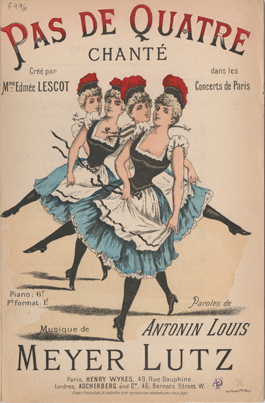There exists in Paris a strange place, exquisite, not at all orthodox, half café, half theatre, as Parisian as possible, very sought out by provincials and tourists. This place is called les Folies-Bergère. There, a crowd gathers every night.
– Émile Zola, “Folies-Bergère” (1882).
The Third Republic (1870–1940) emerged out of the année terrible, a period marked by French military loss in the Franco-Prussian war and the tumultuous Commune uprising. Amid governmental instability, the early years of the Republic witnessed dramatic political, social, demographic, technological, and cultural change. Commonly referred to as the “Belle Époque,” the period also experienced the rise of mass commercial culture and a new form of entertainment that proliferated across the metropolis: the music hall.
 Pas de quatre chantéImported from England, the fashionable music halls offered Tout-Paris a titillating visual spectacle that exhibited a “fundamental tension between elegance and ill repute” (Gutsche-Miller, 2015, 15). The Folies-Bergère was the first music hall in Paris in the 1870s, and numerous imitators opened in the years that followed, including the Olympia, the Parisiana, the Casino de Paris, and the Moulin Rouge (which functioned primarily as a dance hall). With bigger budgets, opulent décor, and a rotation of stars, the music hall offered a varied entertainment—operettas, ballets, popular dances, singers’ tours de chant, gymnastics, circus-act routines (trapeze artists, acrobats, and animal acts), and eventually revues—to an audience that included aristocrats, bourgeois families, students, and the petite bourgeoisie. Interest in the café-concerts began to wane during these years, and many venues responded by either offering music-hall style entertainment or transforming themselves into music halls proper.
Pas de quatre chantéImported from England, the fashionable music halls offered Tout-Paris a titillating visual spectacle that exhibited a “fundamental tension between elegance and ill repute” (Gutsche-Miller, 2015, 15). The Folies-Bergère was the first music hall in Paris in the 1870s, and numerous imitators opened in the years that followed, including the Olympia, the Parisiana, the Casino de Paris, and the Moulin Rouge (which functioned primarily as a dance hall). With bigger budgets, opulent décor, and a rotation of stars, the music hall offered a varied entertainment—operettas, ballets, popular dances, singers’ tours de chant, gymnastics, circus-act routines (trapeze artists, acrobats, and animal acts), and eventually revues—to an audience that included aristocrats, bourgeois families, students, and the petite bourgeoisie. Interest in the café-concerts began to wane during these years, and many venues responded by either offering music-hall style entertainment or transforming themselves into music halls proper.
Just up from the boulevard music halls was Montmartre, the realm of the cabaret artistique. The Chat Noir, founded by Rudolph Salis (1851–1897) in 1881 and immortalized in Théophile Steinlen’s 1896 poster, is arguably the most famous of these cabarets. Others included the Cabaret des Quatz’Arts and the Mirliton, associated with chansonnier Aristide Bruant (1851–1925). Rising out of a post-Commune Montmartre and the working-class goguettes, the cabaret flourished between 1880 and 1900, and positioned itself as an antithesis to what Marc Angenot calls the “silly falsity” of the café-concert (1991, 94). Alongside poetry, theatrical experiments, and shadow plays created by avant-garde artists and writers, singers performed socially critical songs (notably the chanson réaliste and the chanson à Montmartre) for a “bohemian” working-class and bourgeois audience. The anti-establishment songs addressed social injustice, street life, and the underworld of crime and prostitution. Cabarets merged low and high culture, leading Bernard Gendron to view them as “sites of modernist aesthetic practice” that contributed to the development of modernism in the twentieth century (2002, 31). For instance, both Debussy’s and Satie’s musical development was shaped by the fertile ground of the cabaret. Moreover, the cabaret infiltrated other venues: Yvette Guilbert, who briefly performed at the Chat Noir, was responsible for bringing the cabaret repertoire and performance style to the café-concert stage.
Women and the Spirit of France
Women, Spectacle, and the Stage
Sexuality, Desire, and Disruption
Women and Art Song in a New Century
Angenot, Marc. Café-concert: Archéologie d’une industrie culturelle. With Diane Geoffrion. Montréal: CIADEST, 1991.
Appignanesi, Lisa. The Cabaret. New Haven: Yale University Press, 2004.
Caradec, François, and Alain Weill. Le Café-Concert. 2nd ed. Paris: Fayard, 2007.
Gendron, Bernard. Between Montmartre and the Mudd Club: Popular Music and the Avant-Garde. Chicago: University of Chicago Press, 2002.
Gordon, Rae Beth. Dances with Darwin, 1875–1910: Vernacular Modernity in France. Farnham, UK: Ashgate, 2009.
Gutsche-Miller, Sarah. Parisian Music-Hall Ballet, 1871–1913. Rochester, New York: University of Rochester Press, 2015.
Haine, W. Scott. The History of France. Westport, Conn: Greenwood Press, 2000.
Klein, Jean-Claude. La chanson à l'affiche: Histoire de la chanson française du cafe-concert à nos jours. Paris: Du May, 1991.
Loosely, David. “Popular Music.” In The Cambridge Companion to Music in France, edited by Simon Trezise, 271–89. Cambridge: Cambridge University Press, 2015.
Pasler, Jann. Composing the Citizen: Music as Public Utility in Third Republic France. Berkeley and Los Angeles: University of California Press, 2009.
Perloff, Nancy Lynn. Art and the Everyday: Popular Entertainment and the Circle of Erik Satie. Oxford: Clarendon Press, 1991.
Rearick, Charles. Pleasures of the Belle-Époque: Entertainment and Festivity in the Turn-of-the-Century France. New Haven: Yale University Press, 1985.
Sallée, André, and Philippe Chauveau. Music-hall et café-concert. Paris: 1985.
Siegel, Harold B. Turn-of-the-Century Cabaret: Paris, Barcelona, Berlin, Munich, Vienna. New York: Columbia University Press, 1987.
Tilburg, Patricia A. Colette’s Republic: Work, Gender, and Popular Culture in France, 1870−1914. New York: Berghahn Books, 2009.
Weisberg, Gabriel P. Montmartre and the Making of Mass Culture. New Brunswick, NJ: Rutgers University Press, 2001.
Whiting, Steven Moore. Satie the Bohemian: From Cabaret to Concert Hall. Oxford: Oxford University Press, 1999.

